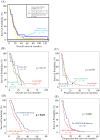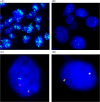Molecular landscape of IDH-wild type, pTERT-wild type adult glioblastomas
- PMID: 35815721
- PMCID: PMC9616088
- DOI: 10.1111/bpa.13107
Molecular landscape of IDH-wild type, pTERT-wild type adult glioblastomas
Abstract
Telomerase reverse transcriptase (TERT) promoter (pTERT) mutation has often been described as a late event in gliomagenesis and it has been suggested as a prognostic biomarker in gliomas other than 1p19q codeleted tumors. However, the characteristics of isocitrate dehydrogenase (IDH) wild type (wt) (IDHwt), pTERTwt glioblastomas are not well known. We recruited 72 adult IDHwt, pTERTwt glioblastomas and performed methylation profiling, targeted sequencing, and fluorescence in situ hybridization (FISH) for TERT structural rearrangement and ALT (alternative lengthening of telomeres). There was no significant difference in overall survival (OS) between our cohort and a the Cancer Genome Atlas (TCGA) cohort of IDHwt, pTERT mutant (mut) glioblastomas, suggesting that pTERT mutation on its own is not a prognostic factor among IDHwt glioblastomas. Epigenetically, the tumors clustered into classic-like (11%), mesenchymal-like (32%), and LGm6-glioblastoma (GBM) (57%), the latter far exceeding the corresponding proportion seen in the TCGA cohort of IDHwt, pTERTmut glioblastomas. LGm6-GBM-clustered tumors were enriched for platelet derived growth factor receptor alpha (PDGFRA) amplification or mutation (p = 0.008), and contained far fewer epidermal growth factor receptor (EGFR) amplification (p < 0.01), 10p loss (p = 0.001) and 10q loss (p < 0.001) compared with cases not clustered to this group. LGm6-GBM cases predominantly showed ALT (p = 0.038). In the whole cohort, only 35% cases showed EGFR amplification and no case showed combined chromosome +7/-10. Since the cases were already pTERTwt, so the three molecular properties of EGFR amplification, +7/-10, and pTERT mutation may not cover all IDHwt glioblastomas. Instead, EGFR and PDGFRA amplifications covered 67% and together with their mutations covered 71% of cases of this cohort. Homozygous deletion of cyclin dependent kinase inhibitor 2A (CDKN2A)/B was associated with a worse OS (p = 0.031) and was an independent prognosticator in multivariate analysis (p = 0.032). In conclusion, adult IDHwt, pTERTwt glioblastomas show epigenetic clustering different from IDHwt, pTERTmut glioblastomas, and IDHwt glioblastomas which are pTERTwt may however not show EGFR amplification or +7/-10 in a significant proportion of cases. CDKN2A/B deletion is a poor prognostic biomarker in this group.
Keywords: EGFR; IDH-wildtype; PDGFRA; TERT promoter; chromosome +7/−10; epigenetic profiling; glioblastoma.
© 2022 The Authors. Brain Pathology published by John Wiley & Sons Ltd on behalf of International Society of Neuropathology.
Conflict of interest statement
All authors declare no conflict no interest.
Figures



Similar articles
-
TERT promoter mutation status is necessary and sufficient to diagnose IDH-wildtype diffuse astrocytic glioma with molecular features of glioblastoma.Acta Neuropathol. 2021 Aug;142(2):323-338. doi: 10.1007/s00401-021-02337-9. Epub 2021 Jun 20. Acta Neuropathol. 2021. PMID: 34148105
-
Distribution of EGFR amplification, combined chromosome 7 gain and chromosome 10 loss, and TERT promoter mutation in brain tumors and their potential for the reclassification of IDHwt astrocytoma to glioblastoma.Acta Neuropathol. 2018 Nov;136(5):793-803. doi: 10.1007/s00401-018-1905-0. Epub 2018 Sep 5. Acta Neuropathol. 2018. PMID: 30187121
-
Combined analysis of TERT, EGFR, and IDH status defines distinct prognostic glioblastoma classes.Neurology. 2014 Sep 23;83(13):1200-6. doi: 10.1212/WNL.0000000000000814. Epub 2014 Aug 22. Neurology. 2014. PMID: 25150284
-
TERT promoter mutation and its interaction with IDH mutations in glioma: Combined TERT promoter and IDH mutations stratifies lower-grade glioma into distinct survival subgroups-A meta-analysis of aggregate data.Crit Rev Oncol Hematol. 2017 Dec;120:1-9. doi: 10.1016/j.critrevonc.2017.09.013. Epub 2017 Oct 3. Crit Rev Oncol Hematol. 2017. PMID: 29198322 Review.
-
Clinical characteristics and radiological features of glioblastoma, IDH-wildtype, grade 4 with histologically lower-grade gliomas.Brain Tumor Pathol. 2023 Apr;40(2):48-55. doi: 10.1007/s10014-023-00458-5. Epub 2023 Mar 29. Brain Tumor Pathol. 2023. PMID: 36988764 Review.
Cited by
-
Alternative lengthening of telomeres is seen in a proportion of oligodendrogliomas and is associated with a worse prognosis.Neurooncol Adv. 2024 Feb 9;6(1):vdae006. doi: 10.1093/noajnl/vdae006. eCollection 2024 Jan-Dec. Neurooncol Adv. 2024. PMID: 38371225 Free PMC article. No abstract available.
-
The molecular history of IDH-mutant astrocytomas without adjuvant treatment.Brain Pathol. 2025 Mar;35(2):e13300. doi: 10.1111/bpa.13300. Epub 2024 Oct 30. Brain Pathol. 2025. PMID: 39473241 Free PMC article.
-
Rare Pediatric Cerebellar High-Grade Gliomas Mimic Medulloblastomas Histologically and Transcriptomically and Show p53 Mutations.Cancers (Basel). 2024 Jan 4;16(1):232. doi: 10.3390/cancers16010232. Cancers (Basel). 2024. PMID: 38201659 Free PMC article.
-
Differences in methylation profiles between long-term survivors and short-term survivors of IDH-wild-type glioblastoma.Neurooncol Adv. 2024 Jan 12;6(1):vdae001. doi: 10.1093/noajnl/vdae001. eCollection 2024 Jan-Dec. Neurooncol Adv. 2024. PMID: 38312227 Free PMC article.
-
Favorable prognostic impact of phosphatase and tensin homolog alterations in wild-type isocitrate dehydrogenase and telomerase reverse transcriptase promoter glioblastoma.Neurooncol Adv. 2023 Jun 28;5(1):vdad078. doi: 10.1093/noajnl/vdad078. eCollection 2023 Jan-Dec. Neurooncol Adv. 2023. PMID: 37528810 Free PMC article.
References
Publication types
MeSH terms
Substances
LinkOut - more resources
Full Text Sources
Medical
Research Materials
Miscellaneous

